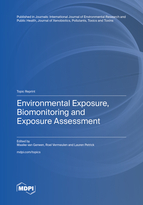Topic Menu
► Topic MenuTopic Editors

Environmental Exposure, Biomonitoring and Exposure Assessment

A printed edition is available here.
Topic Information
Dear Colleagues,
It is well-established that environmental exposures play an important role in the development of diseases such as cancer. However, individuals are exposed to complex mixtures of substances (e.g., chemicals, pollution, and diet) that change throughout a person’s life. Therefore, measuring these different exposures and investigating their association with disease is complicated, though necessary, as it forms the basis of individual risk assessment of the variety of environmental exposures. Biomonitoring, which is the quantitative measurement of environmental chemicals/pollutants in the human body, is used to evaluate an individual’s exposure. The appropriate utilization of biomonitoring provides information on occupational as well as non-occupational exposures. When the chemicals of interest are unknown, untargeted approaches, such as metabolomics, are used to generate semiquantitative measurements of internal exposures. These are complemented with environmental monitoring—performing external exposure measurements from lifestyle and unavoidable exposures which are mapped and quantified by wearable sensors and environmental samples. These techniques help identify unintentional and unexpected exposures, which are difficult to tease out using more conventional techniques such as exposure questionnaires. Once obtained, exposure data are compared to animal/human data to determine an individual’s risk of disease, are used to evaluate the effectiveness of policy actions, and are used to detect emerging contaminants. In this Topic, we invite authors to submit high-quality original research, reviews, short communications, and commentaries highlighighting research on the intersection between environmental exposures, biomonitoring, and the assessment of health risks.
Dr. Maaike van Gerwen
Prof. Dr. Roel Vermeulen
Dr. Lauren Petrick
Topic Editors
Keywords
- exposure
- risk assessment
- biomonitoring
- epidemiology
- diseases
Participating Journals
| Journal Name | Impact Factor | CiteScore | Launched Year | First Decision (median) | APC |
|---|---|---|---|---|---|

International Journal of Environmental Research and Public Health
|
- | 8.5 | 2004 | 27.8 Days | CHF 2500 |

Journal of Xenobiotics
|
4.4 | 6.0 | 2011 | 27.6 Days | CHF 1600 |

Pollutants
|
- | - | 2021 | 40 Days | CHF 1000 |

Toxics
|
4.1 | 6.4 | 2013 | 18.1 Days | CHF 2600 |

Toxins
|
4.0 | 8.2 | 2009 | 18.4 Days | CHF 2700 |

Preprints.org is a multidisciplinary platform offering a preprint service designed to facilitate the early sharing of your research. It supports and empowers your research journey from the very beginning.
MDPI Topics is collaborating with Preprints.org and has established a direct connection between MDPI journals and the platform. Authors are encouraged to take advantage of this opportunity by posting their preprints at Preprints.org prior to publication:
- Share your research immediately: disseminate your ideas prior to publication and establish priority for your work.
- Safeguard your intellectual contribution: Protect your ideas with a time-stamped preprint that serves as proof of your research timeline.
- Boost visibility and impact: Increase the reach and influence of your research by making it accessible to a global audience.
- Gain early feedback: Receive valuable input and insights from peers before submitting to a journal.
- Ensure broad indexing: Web of Science (Preprint Citation Index), Google Scholar, Crossref, SHARE, PrePubMed, Scilit and Europe PMC.



